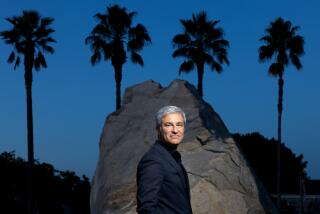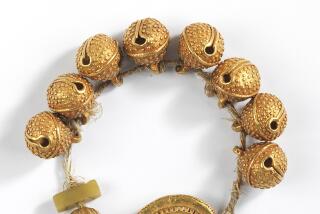Home and Office Is Part of World’s Greatest Treasure House : Director of the British Museum Lives for--and With--His Work
LONDON — Sir David M. Wilson is in charge of the most famous treasure house on Earth, the British Museum, and he can’t get away from it.
“The founders decreed that the director live on the site, so here I am,” Wilson said. “There are board meetings on Saturdays, and we seem to be a dumping-off place for VIPs, who come at weekends.”
From his home and office windows in the west residence, the director--only the 17th since 1756--can see 3 million to 4 million visitors a year pour in, seven days a week, to gaze at the world’s richest collection of historical objects: Assyrian statues, Egyptian mummies, Greek vases, Chinese jade and 2,000 years of British coins.
Literally Innumerable
They are among 7 million artifacts--in addition to flints, of which there are too many to count.
The Wilsons’ tall, narrow house, part of architect Robert Smirke’s original museum complex and little altered since it was completed in 1849, has four floors and a basement, as well as a tiny herb and flower garden.
When the house was built, museum directors had servants who lived in the attic. The Wilsons have only a cleaning woman who comes to help out.
Curtains in a second-floor reception room are left open, giving guests a nighttime view of the flood-lit museum facade.
Besides treasures, Wilson presides over an intimidating collective of scholars.
“That can be hell,” he confided. “I can usually get something done about the washrooms, but other things can lead to the most amazing rows.”
Managing folks outside the museum family is almost as difficult.
“Some outsiders think we should remain a monument and not be a lively museum, so we find ourselves assailed for wanting to redecorate the front hall,” Wilson said.
The museum, which includes 1,000 staff members and 14 acres behind its grand neoclassical facade, “is an exciting place,” Wilson said. “Knowledge of any area of culture in the world is available here, and no matter how obscure the subject, there is someone who can give an opinion on it.”
He said the museum is so famous that the French refer to it simply as “Le British,” considering it the only cultural thing in the country.
“If the French say it’s cultural, it must be,” he said with a grin.
The museum has enormous prestige, which rubs off on everyone who works there, giving its researchers and collectors an edge when they go out in the world.
“We are often the ultimate authority,” Wilson said, “and we can collect in areas that aren’t fashionable. We now have an expedition in Madagascar gathering ethnographic material from a primitive area. No one else has done it. We got in because we are the British Museum.”
Sir David, 54, is the son of a Methodist minister and is Britain’s leading expert on Viking life and times. He is only the second archeologist appointed to director. His wife, Eva, is a Swedish illustrator.
He studied archeology at Cambridge, did postgraduate studies in Sweden, because he wanted to specialize in the Vikings, and enlarged his field to the Anglo-Saxons in northwest Europe from AD 400 to AD 1100.
“That period used to be called the Dark Ages, but it’s better known now,” he said.
His career began at the British Museum, and he returned there in 1977 after answering an advertisement for the directorship. “I was interviewed by half the peerage of England,” Wilson said jokingly.
Many of the museum’s trustees are peers of the realm, headed by the Duke of Gloucester, cousin of Queen Elizabeth II.
The director gets $51,100 a year, a small fraction of the $18 million a year the museum costs Britain to run.
“It sounds like a lot, but 60% to 70% of our visitors are tourists who bring vast sums of money into the country,” Wilson said.
Government grants below inflation levels have led the National Maritime Museum to impose entry fees, and now the Victoria and Albert Museum is asking visitors to pay. The British Museum, however, stoutly resists.
“I would hate to have to charge,” Wilson said. “The most advanced museums, like the Smithsonian and the National Gallery of Art in Washington, D.C., are free.
“It would be the wrong people who would feel it. We have many young visitors, and a lot of them might find it difficult to come.”
As a measure of how charges keep people away, he cites two of his exhibitions, drawings by Raphael and by Rubens. They were the same size, opened at similar times and with similar catalogues.
“We charged for the Raphael, which had 60,000 visitors,” he said. “The Rubens was free, and we had over 200,000.”
Wilson has spent eight years getting his mid-19th-Century building watertight, cleaning the front, opening new galleries and redesigning labels to “make more people understand what they see.”
His work is often strapped for funds. He has just appealed for $7 million to establish a gallery and study center for the museum’s 20,000 Japanese art objects, hoping to get most of it from Japanese industrialists.
On collecting, he said the museum “has to be prescient for the future by buying the past.”
Among recent acquisitions are pre-1935 German Expressionist prints, a bank note collection and 1 million trade and cigarette cards of the last 100 years, “which give us the world’s best collection.”
Don’t Break Up the Best
How does Wilson feel about the sporadic demand for the return of previously collected treasures to their countries of origin, which, to mention only one, would sweep the Elgin Marbles back to Athens?
“I’m against it,” Wilson said. “If you start to disperse a representative museum, you are destroying part of the world’s culture for the benefit of narrow nationalism.
“Only here, for example, can you study the whole of Africa and the whole of South America. And our conservation complex is so large that it can advise developing countries on looking after their collections.
“Even in countries loud in their demands, the curators say, ‘You must not take this seriously--we know what the British Museum is doing.’ ”
More to Read
Sign up for The Wild
We’ll help you find the best places to hike, bike and run, as well as the perfect silent spots for meditation and yoga.
You may occasionally receive promotional content from the Los Angeles Times.






